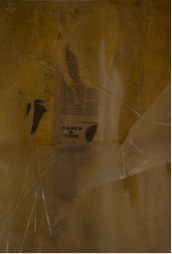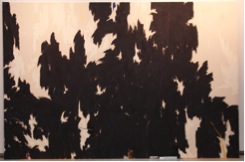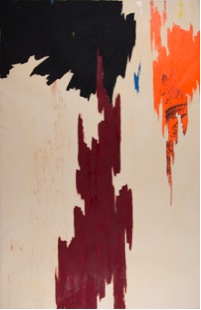by James Squires, associate conservator of paintings
As I continue to unroll Still’s paintings, some of which haven’t seen the light of day for more than fifty years, I’m astounded at their generally good structural and aesthetic condition. Some look and smell (literally) as if they were just painted. There are those though that need conservation treatment. Handling caused some of the damages while others are the result of their storage, and there are some changes that are simply curiosities.
During the recent keynote address, I highlighted some of these changes to the pictures and pressed for the need for continued research into Still’s materials and techniques. Still was a traditionalist in many ways – he mixed his own paints like the Old Masters and prepared his canvases similarly. And like the Old Masters, whose pictures have changed over time, so have Still’s paintings. Some of the changes to older pictures can be resolved through conservation treatment while others cannot, like the presence of fine cracks, called craquelure, formed in the paint during drying. Indeed, some of these changes to old pictures we expect to see, for they signify the painting’s age and have become part of the painting’s ‘look.’ Still’s paints are also changing over time and the ‘look’ of an older Clyfford Still picture is yet to be determined. Further research into Still’s materials and techniques helps conservators, curators, and scholars alike to understand the changes we’re seeing in Still’s paintings and determine whether those changes can be safely resolved. In some cases, like the craquelure in old pictures, some changes may become signifiers of age for Still’s artworks.
Following are a few examples of the changes I’ve observed to Clyfford Still’s artwork. Some are superficial and predictable while others are true conundrums.

As I mentioned earlier, the vast majority of Still’s pictures came to the Museum rolled. Though rolling is generally an acceptable method of storage for larger pictures, it is not ideal. In the case of Still, he rolled (up to 11 per roll) them out of necessity. He had no space to store all of his work.
The above detail of painting PH-1125 shows both newsprint and wax paper adhered to the paint surface. Still probably added these materials as barrier layers prior to rolling, but the surface was not completely dry, thus pressing into the paint surface. In most cases, this sort of problem is readily resolvable with minimal damage to the artwork.
Oil paint, while transforming from a viscous paste to a hard film, off-gas different materials into the atmosphere. If a picture was rolled before the paint has completely dried, often efflorescence occurs.

Effloresence is a general term to describe often white colored exudations on the paint surface. This can be seen in painting PH-929 (above left) and the detail of the painting to the above right. Some are caused by additives to the artist’s paint, others, like the one above is caused by the paint drying without adequate exposure to oxygen. Specifically it is called ‘fatty acid bloom,’ the formation of a fatty acid (think soap) on the surface of the picture. This residue forms because components of the oil media could not adequately dry in the presence of oxygen and carbon dioxide. This phenomenon is also readily resolvable.
The final is simply a curiosity to me.

The black color seen in the orange pigment appears as a mold or mildew that singularly attacked that orange paint. Close observation of the detail image shows how the back color seems to have penetrated the orange color and concentrates at the edges. Further technical research to characterize Still’s materials and art historical research to learn his methods of manufacture will be very helpful to understanding what is happening in the above example. I look forward to explaining this phenomenon in future blog posts.
